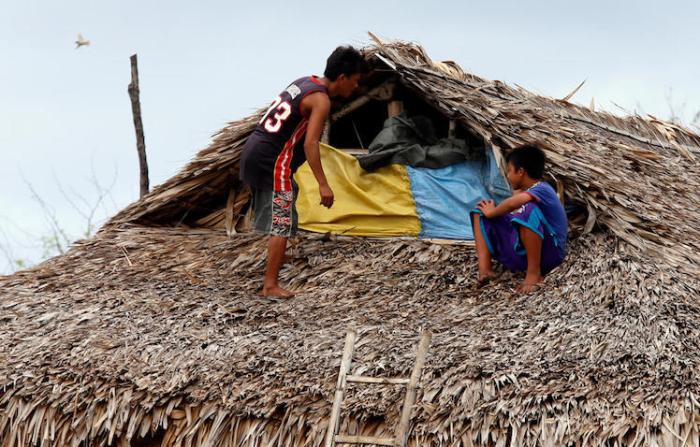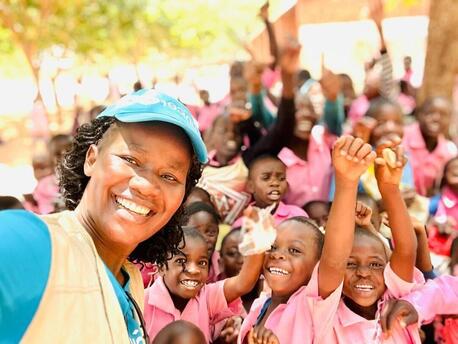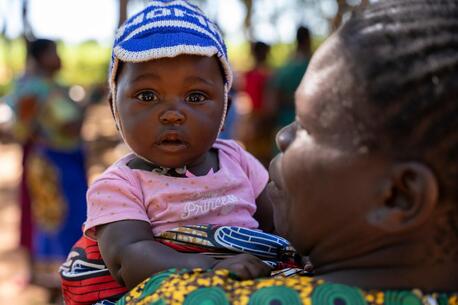
Typhoon Mangkhut Leaves a Trail of Death and Destruction
The search for survivors continues as Typhoon Mangkhut moves northward. The monster storm whipped through the Philippines and Hong Kong before reaching Guangdong, China's most populous province, on Sunday, leaving a trail of damage throughout the region. UNICEF is closely monitoring the 168-mile-wide storm's progress.
Typhoon Mangkhut is the strongest storm of 2018

Boys fix the roof of their house in Ilocos Norte, the Philippines on September 14, 2018. © UNICEF/UN0235923/Maitem
Mangkhut — known as Ompong in the Philippines — caused major flooding and landslides across the Philippines' main island of Luzon when it came ashore early Saturday. The total number of fatalities is still unknown. Earlier today, rescuers in the mining town of Itogon found the bodies of at least 32 people crushed to death in a landslide. UNICEF is working with authorities in the Philippines in the areas of child protection, nutrition, health, education and hygiene.
Millions have been evacuated across the region

Children wait to get food at the school turned evacuation center in Ilocos Norte on September 14, 2018. © UNICEF/UN0235926/Maitem
Winds of up to 107 miles per hour tore the roofs off of houses and ripped windows from high-rise buildings in Hong Kong. Officials in China ordered the evacuation of more than 3 million people. In the Philippines, schools and government buildings were turned into shelters to house the thousands of evacuees fleeing the storm. Almost 300,000 children are estimated to be impacted in the typhoon's aftermath.
"In any crisis, children are among the most vulnerable, and the extreme weather events we are seeing around the world are no exception," said Unicef Director of Programs Ted Chaiban. "Over the past few months, we have seen a stark vision of the world we are creating for future generations. As more extreme weather events increase the number of emergencies and humanitarian crises, it is children who will pay the highest price.”
Children are the most vulnerable in any emergency situation

Fleeing Super Typhoon Mangkut, 22-yaer-old Rogeline kisses her 1-month-old daughter, Kristan, at a school turned evacuation center in Ilocos Norte on September 14, 2018. © UNICEF/UN0235931/Maitem
Across the globe, when emergencies strike, UNICEF is always committed to helping children and families survive and stay safe and healthy. Last year alone, UNICEF responded to 337 humanitarian emergencies — from conflicts to natural disasters — in 102 countries. Working with local partners, UNICEF steps up where help is needed most, delivering urgently needed supplies like safe drinking water, hygiene sanitation kits and medicines. Trained staff offer psychosocial support and educational materials to get children back to learning and playing as soon as possible.
Please support UNICEF in getting emergency relief to those most in need around the world.
Top photo: Super Typhoon Mangkut looms over the northern Pacific on September 12, 2018. ©NOAA
HOW TO HELP
There are many ways to make a difference
War, famine, poverty, natural disasters — threats to the world's children keep coming. But UNICEF won't stop working to keep children healthy and safe.
UNICEF works in over 190 countries and territories — more places than any other children's organization. UNICEF has the world's largest humanitarian warehouse and, when disaster strikes, can get supplies almost anywhere within 72 hours. Constantly innovating, always advocating for a better world for children, UNICEF works to ensure that every child can grow up healthy, educated, protected and respected.
Would you like to help give all children the opportunity to reach their full potential? There are many ways to get involved.





